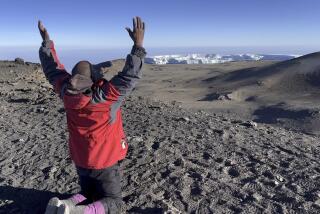African Safari Is Genuine Adventure
- Share via
I always expected it would be the exotic animals that would impress me most about East Africa. They were fabulous, of course. But the highlight of my safari in Tanzania was meeting and living with the Masai people, spear-carrying tribesmen who were as curious about me as I was about them.
Our group traveled in a sturdy British truck designed to carry the military, which now carried instead 16 adventure-seeking Americans, a driver, two cooks and our naturalist, Howie Olson. As the trip progressed, I came to understand how a guide can make or break your trip.
During our 19-day safari we visited Serengeti and Lake Manyara national parks, Ngorongoro Conservation Area and Olduvai Gorge, the site where the Leakeys found bones of some of the oldest-known humans.
On the second night we made camp along a river bank with a group of Masai. Here we would stay for a few days exploring the area. Just yards from the tents we set up were rough dome-shaped structures called bomas.
Cattle Take Over
That evening some of us swam in the river to shed the dust we had accumulated during the day. Relaxing, immersed neck-high in the cool water, I admired the distant spectacle of Mt. Ol Doinyo Lengai illuminated in the colors of the sunset, too comfortable to get out of the water to photograph the scene.
Suddenly a herd of cattle came thundering noisily over and down the embankment, followed by several Masai tribesmen.
Hastily I threw on my clothes and hurried back to the campsite. A dozen or so Masai women and children there wore colorful bead work and carried hollowed-out gourds filled with milk.
Our guide, Olson, encouraged us to trade with them and we found that the Masai were more than willing to exchange their handmade bracelets and armbands for our T-shirts. Even though they don’t wear Western clothing, they sell such items to other Africans to raise money to buy glass beads and medicine.
Time for Communicating
Beyond exchanging goods, we were all very curious about each other. Even the language barrier didn’t stop us from communicating during the few days we spent with them. We shared bubble gum, painted a young girl’s fingernails and entertained each other with the hand games familiar to schoolchildren.
The Masai mothers welcomed the small rattles I made out of empty film cans for their babies. They laughed at the size of our pierced ears, comparing them to their own elongated ear lobes from which hung massive jewelry. They asked us to open our mouths and when they saw the fillings in our teeth, it was difficult for us to explain why we had them.
It was thrilling to be in touch with a culture as innocent as the Masai. Some felt so comfortable with us that they fell asleep in the middle of the camp, pulling their earth-colored togas over their heads while they snoozed on the bare ground.
We saw our first wild animal as we drove into the great Rift Valley. This was what we’d traveled 10,000 miles for. All 16 of us twisted binoculars to see the tall, stately giraffe.
Reality on the Move
At first we joked about how it was probably a stuffed decoy placed there by the tour company. But then in rapid succession we began to see other creatures--Thomson’s gazelles, wildebeest, zebra and flamingos--and the reality of being in Africa began to sink in.
It was very special to see a cheetah and awe-inspiring to get within 50 feet of a wild elephant, a pride of lions or the endangered black rhinoceros. Olson made us feel secure but also made sure that we were realistically aware of the wildlife that surrounded us.
Our meals were generally good and the lodging, which consisted of roomy tents, was adequate if not luxurious. If our tour had a fault, it was the company’s compunction to make us see as much game as physically possible, even though there were times when most of us wished for a reprieve--a chance to sleep in, even though we might miss seeing one more animal.
Although there was never a shortage of drinking water and there was always enough for washing, we sometimes went three days without a shower. A few times, when we camped near a lodge, we paid for a cold shower.
Plenty of Fresh Food
Our two cooks always provided fresh fruit and vegetables to brighten up mealtimes. Breakfast invariably consisted of granola, fresh fruit and freshly baked bread. Toward the end of the safari we stopped along the roadside to buy eggs from a young boy who kept them in a crudely made basket that looked like a bird’s nest. Nicholas, our head cook, counted out enough eggs for two days while the boy calculated the price by scratching the numbers into his forearm with a stick.
Before going on safari, I was concerned that I would dislike camping out for so many days. My fears were unfounded. One item that definitely helped me enjoy it was a small, self-inflating air mattress. It cost $35 and was well worth the price because I slept quite comfortably, whereas I heard complaints from others who were sleeping on the conventional air mattresses that were provided.
Sleeping alone in a tent on safari does wonders for the spirit. In the evening I would snuggle into my sleeping bag and lie awake as long as I could, my head close to the mosquito netting so I could catch every sound in the active African night. There was the unmistakable roar of a lion, the stealthy footsteps of smaller animals, a slithering sound through the grass of . . . a snake? We heard the raucous laughter of the hyenas and the heavy tramping of elephants drumming the ground in the distance.
Big Noise, Tiny Animal
The nights gave us some of our scariest experiences and best anecdotes. A recent Harvard business school graduate told us about trying in vain to wake his tentmate after the piercing sound of a hyrax woke most of the camp. Only the next morning did we learn that this harmless animal is only about a foot long and spends most of its time in trees.
One late evening, as some of us sat around the campfire, a doctor from New York walked toward us, flashlight in hand. His voice sounded peculiarly high as he asked our guide to take a look around his tent. “I could swear I hear something chewing behind the tent and I don’t want my wife to be frightened.” We all chuckled because we knew that his wife had gone to sleep hours before. They returned with grins and reported finding a one-ton Cape buffalo chomping on some tall grass behind the tent.
Olson did his best to slow us down when we all jumped up to take a closer look at this giant. It was electrifying to see the buffalo up close and yet so oblivious to our presence.
Good Conversation
My fellow safari-goers turned out to be another memorable part of the trip. Evenings were spent in warm cordiality filled with stimulating discussions: the politics of Tanzania, the animals, American movies and our individual lives.
The group gained a certain dimension after living so closely with one another. I have kept in touch with several of my safari friends and none of us would hesitate to travel by truck and tent through East Africa again.
The 19-day safari was arranged by Overseas Adventure Travel, 6 Bigelow St., Cambridge, Mass. 02139, phone toll-free (800) 221-0814 or (617) 876-0533. The 19-day land cost was $1,650 and the air fare $1,750 round trip from Los Angeles.
More to Read
Sign up for The Wild
We’ll help you find the best places to hike, bike and run, as well as the perfect silent spots for meditation and yoga.
You may occasionally receive promotional content from the Los Angeles Times.






